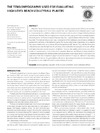Please use this identifier to cite or link to this item:
https://accedacris.ulpgc.es/jspui/handle/10553/45888
| Title: | The tensiomyography used for evaluating high level beach volleyball players | Other Titles: | Tensiomiografia utilizada para a avaliação de jogadores de vôlei de praia de alto nível | Authors: | Rodriguez Ruiz, David Quiroga Escudero, Miriam Esther Rodríguez Matoso, Dario Sarmiento Montesdeoca, Samuel Losa Reyna, José Saá Guerra, Yves de Perdomo Bautista, Gloria García Manso, Juan Manuel |
UNESCO Clasification: | 241106 Fisiología del ejercicio | Keywords: | Tensiomyography Evaluation of the muscles Symmetries Beach volleyball Stiffness |
Issue Date: | 2012 | Publisher: | 1517-8692 | Journal: | Revista Brasileira de Medicina do Esporte | Abstract: | OBJECTIVE: The aim of this investigation is to obtain information about muscle stiffness, the mechanic and contractile properties of the muscles using the TMG with high level beach volleyball players as well as to demonstrate the usefulness of this method to evaluate the muscles in charge of the knee flexion and extension. METHODS: The investigation was carried out with a group of 24 beach volleyball players who took part in the Nestea European Championship Tour - Spanish Master held in the Gran Canaria, May 2009. The method of study used was a comparison of the individual cases of various athletes to ascertain the usefulness of this method in sports. The muscles which were analyzed are: vastus lateralis (VL), vastus medialis (VM), rectus femoris (RF) and biceps femoris (BF). RESULTS: Thus, with the information collected we can state the high level of usefulness of this method for the evaluation of muscle stiffness and balance between muscle structures of athletes. However, the validity and reconstruction of the results are conditioned to a strict protocol of evaluation. Moreover, the following criteria should be considered: individuality (the athlete's profile) and specifications (sport characteristics). CONCLUSIONS: The application of the TMG to high level players reveals the existence of important differences depending on their different roles in the game (defence, blocker or alternating both roles), the technical actions, the position on court (right-left) and the medical history of injuries. | URI: | https://accedacris.ulpgc.es/handle/10553/45888 | ISSN: | 1517-8692 | DOI: | 10.1590/S1517-86922012000200006 | Source: | Revista Brasileira de Medicina do Esporte [ISSN 1517-8692], v. 18 (2), p. 95-99, (Marzo 2012) |
| Appears in Collections: | Artículos |
SCOPUSTM
Citations
21
checked on Jun 8, 2025
WEB OF SCIENCETM
Citations
18
checked on Feb 25, 2024
Page view(s)
196
checked on May 31, 2025
Download(s)
226
checked on May 31, 2025
Google ScholarTM
Check
Altmetric
Share
Export metadata
Items in accedaCRIS are protected by copyright, with all rights reserved, unless otherwise indicated.
